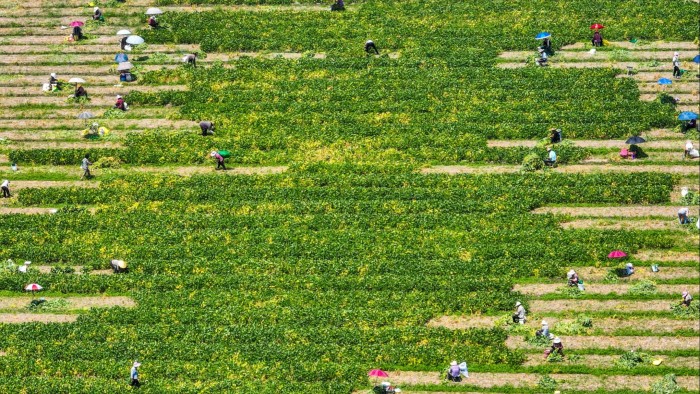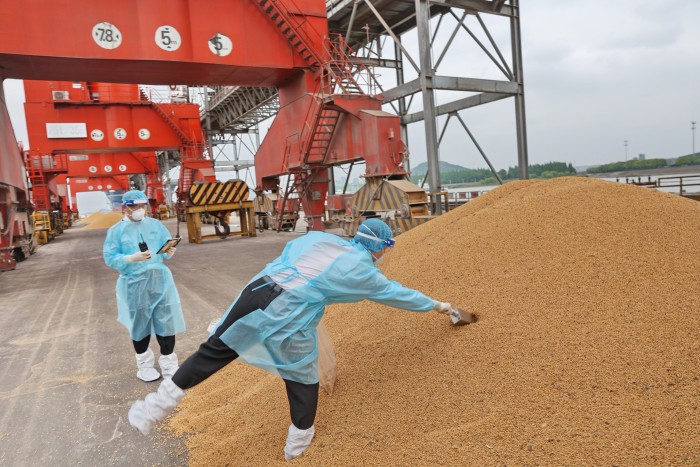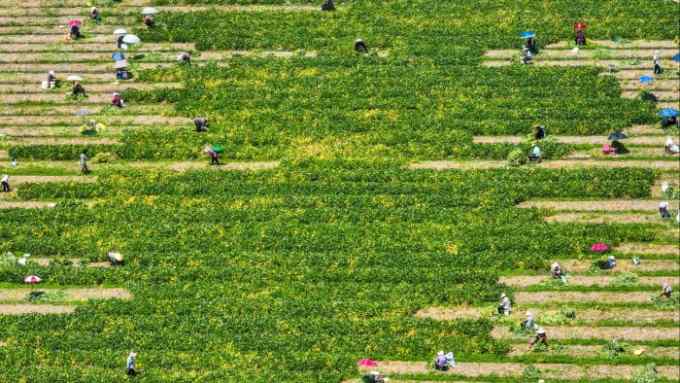Appetite for soya hinders China’s self-sufficiency drive

Roula Khalaf, Editor of the FT, selects her favourite stories in this weekly newsletter.
China’s drive for self-sufficiency, as trade links fray with the US, is not confined to the cutting-edge likes of semiconductors and missile technology. The humble soyabean, too, is weighing on the minds of the nation’s leaders, and has become the unlikely subject of a national campaign to boost output.
A cheap and versatile source of protein for both people and, especially, animals (which consume about three-quarters of the global harvest), soya is a key part of the global food system. It is also a commodity for which China is heavily reliant on foreign suppliers — to the discomfort of its government.
“Food security is a deep-rooted issue with Chinese policymakers,” says Scott Rozelle, a development economist and expert on Chinese agriculture at Stanford University. Those roots lie in the ravages of Mao Zedong’s Great Leap Forward, a disastrous collectivisation campaign that caused widespread famine.
Rozelle adds that US food blockades against Japan during the second world war intensified Beijing’s obsession with food security. More recently, tensions with key agricultural trading partners and a spike in global food prices following the Covid-19 pandemic and Russia’s invasion of Ukraine have given the issue renewed salience. This is after decades of liberalising reforms that increased reliance on some foreign-sourced foods.
China grows much of the staples that it consumes, even if they are produced at a higher cost than for other big global producers. Through protective tariffs, subsidies for farmers, and huge government-run grain warehouses, the country has maintained a high degree of self-reliance with staples: researchers estimate that China’s self-sufficiency rates for rice and wheat were 98.6 per cent and 96.8 per cent, respectively, in 2020.
But the glaring exception is soyabeans. Around three-quarters of the soyabeans China consumes come from the US and Brazil. Of the 95mn-97mn tonnes of soyabeans China imports yearly, more than 80 per cent of them are processed into animal feed, primarily for the country’s pork industry.
China lacks the favourable growing conditions enjoyed by the US and Brazil. It has also not yet adopted genetically modified (GM) varieties at scale, because of consumer resistance to the idea and a fear of relying on imported GM seeds. As a result, the cost of growing soyabeans is 1.3 times higher in China than in the US, and the yield is 60 per cent lower.
The US-China trade war, which kicked off in 2018 when US president Donald Trump began levying tariffs on Chinese imports, prompted Beijing to diversify away from its primary source of soyabeans and to direct farmers to increase local production.
Authorities in China have reclaimed more than 170,000 hectares of land since 2021 to plant corn and soyabeans to bolster food security. The government has also directed farmers to plant soyabeans alongside other crops to increase production. Last year, China increased the area of soyabean fields to 10.3mn hectares, the largest area since 1958, and pushed output to its highest levels of just over 20mn tonnes.
However, Darin Friedrichs, director of market research at Sitonia Consulting, a Shanghai-based agricultural consultancy, says local supplies cannot make up for the shortfall from the US. “No matter how much China tries to increase domestic production, there is no way it can replace US soyabeans, given the size of market demand and the limited arable land,” he says.

Chinese president Xi Jinping remains committed to a homegrown policy, though. He said in a speech last year that authorities must take “hard measures that grow teeth” to maintain 120mn hectares of cultivated land across China — the level officials see as necessary for self-sufficiency. “China must be able to feed its people on our own,” said Xi. “We will fall under others’ control if we can’t hold our rice bowl steady.”
Beijing’s drive to cut its reliance on foreign agriculture — even when it is cheaper than domestic alternatives — and to incentivise farmers to replace high-earning crops such as fruits and vegetables with basic grains is already having a ripple effect on global agricultural trading flows.
Even so, experts say that market forces still predominate and the Chinese government has limited capacity to force farmers to align their cropping plans with its self-sufficiency targets.
“The government coffers are empty,” says Rozelle. “There isn’t much ability to intervene and overturn the market.” The fragmented nature of the agricultural sector — the average farm size is less than one hectare — also means top-level directives often do not filter down.
China’s small farms also create bottlenecks in the adoption of high-tech farming practices, says Friedrichs, pointing to the use of GPS monitoring devices on industrial farms in the US and Brazil, which help farmers to make precise decisions on when to plant and how much fertiliser to apply. “Most [Chinese] farmers don’t have the kind of scale,” he says.
Similarly, China has shunned GM crops, which experts say would bolster food security. “China has been on the verge of adopting GM rice for around a decade,” says Kym Anderson, emeritus professor of economics at the University of Adelaide and an expert on Chinese agriculture. “But, each time the decision comes around, they have chosen not to go down this route.” Beijing, he says, is reluctant to “create controversy” with consumers.
Beijing’s focus on food security is only set to intensify. China is experiencing more extreme weather events, including droughts across the south last year, which affected an estimated 2.2mn hectares of land, and flooding in Henan province the year before. Rising temperatures in the rice-growing regions in the south have further exacerbated official concern about food security and China’s ability to feed its 1.4bn people.
“It comes down to the size of China’s market,” says Friedrichs. “If Thailand has a bad rice crop, you can import from the global market. But, given China’s size, if it has a major crop failure, there is no capacity in the world, not enough grain, not enough boats to supply its need.”

Comments